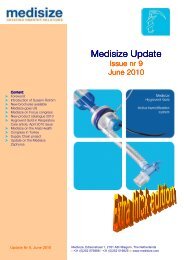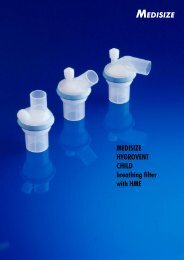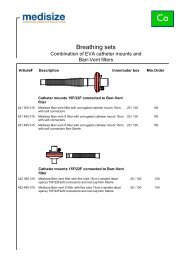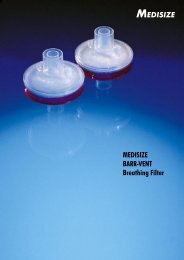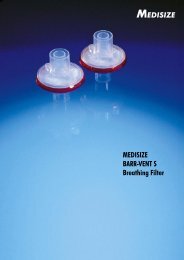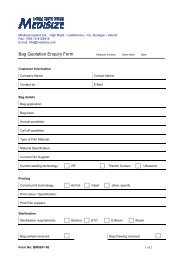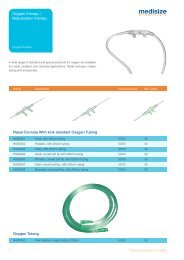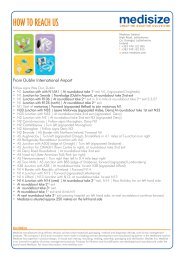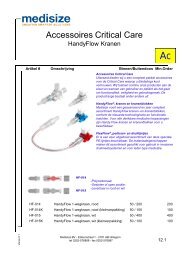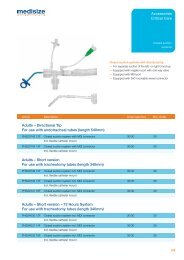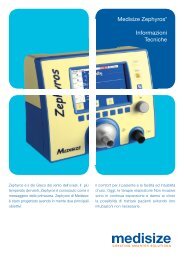HME Booster in AARC Times March 2009 - Medisize
HME Booster in AARC Times March 2009 - Medisize
HME Booster in AARC Times March 2009 - Medisize
You also want an ePaper? Increase the reach of your titles
YUMPU automatically turns print PDFs into web optimized ePapers that Google loves.
Cl<strong>in</strong>ical Perspectives<br />
New Developments <strong>in</strong> Mechanical Ventilation<br />
and Humidification<br />
While controversy cont<strong>in</strong>ues around the issue of<br />
how much humidity is optimal and studies report what<br />
may appear to be conflict<strong>in</strong>g results, cl<strong>in</strong>icians at the<br />
bedside choose daily which device is appropriate for patients<br />
under their care. This article reviews current literature<br />
and new devices <strong>in</strong> an effort to determ<strong>in</strong>e what<br />
impact new <strong>in</strong>formation may or may not have on present<br />
standards of care and the <strong>AARC</strong> Cl<strong>in</strong>ical Practice Guidel<strong>in</strong>e,<br />
“Humidification Dur<strong>in</strong>g Mechanical Ventilation.” 1<br />
<strong>in</strong>g fully saturated gas at core temperature offers significant<br />
benefit to <strong>in</strong>tubated patients.<br />
Heat and moisture exchangers<br />
Heat and moisture exchangers (<strong>HME</strong>s) store heat<br />
and moisture from the patient’s exhaled gas, which is<br />
released to the patient dur<strong>in</strong>g the next <strong>in</strong>spiration. The<br />
<strong>AARC</strong> Cl<strong>in</strong>ical Practice Guidel<strong>in</strong>e recommends that an<br />
<strong>HME</strong> provide a m<strong>in</strong>imum of 30 mg H 2 O/L of delivered<br />
gas at 30°C. 1 There is variability <strong>in</strong> the performance of<br />
Why we do what we do<br />
Dur<strong>in</strong>g normal breath<strong>in</strong>g, <strong>in</strong>spired gas is heated and<br />
humidified while travel<strong>in</strong>g through the upper airways.<br />
The isothermic saturation boundary<br />
(ISB) is the po<strong>in</strong>t at which <strong>in</strong>spired gas<br />
reaches body temperature and is fully<br />
saturated (44 mg H 2 O/L at 37°C). This<br />
<strong>HME</strong>s; but even the most efficient will return only a<br />
limited amount of heat and moisture, and <strong>HME</strong>s must<br />
be removed from the circuit for aerosolized medication<br />
adm<strong>in</strong>istration. Performance may also<br />
be affected by changes <strong>in</strong> m<strong>in</strong>ute ventilation<br />
or tidal volume. 3 <strong>HME</strong>s may<br />
<strong>in</strong>crease resistance and work of<br />
normally occurs around 5 cm below the<br />
breath <strong>in</strong>g. 3,4 In patients ventilated<br />
car<strong>in</strong>a. Endotracheal <strong>in</strong>tubation bypasses<br />
the upper airway’s efficient<br />
with lung protective strategies, the <strong>in</strong>creased<br />
deadspace may contribute to<br />
mechanisms for heat<strong>in</strong>g and humidify<strong>in</strong>g<br />
hypercapnea. 4 Contra<strong>in</strong>dications for<br />
<strong>in</strong>spired gas, creat<strong>in</strong>g a humidity<br />
use <strong>in</strong>clude hypothermia, bron-<br />
deficit and shift<strong>in</strong>g the ISB further <strong>in</strong>to<br />
the respiratory tract. This may lead to<br />
underhumidification and mucociliary<br />
transport dysfunction with resultant<br />
loss of airway patency, mucous plugg<strong>in</strong>g,<br />
chopleural fistula, hemoptysis, thick<br />
or copious secretions, and spontaneous<br />
m<strong>in</strong>ute volume greater than 10<br />
L/m<strong>in</strong>ute. 1 Key advantages of the <strong>HME</strong><br />
<strong>in</strong>clude lower cost, ease of use, and<br />
atelectasis, and <strong>in</strong>fection. Williams et al<br />
portability.<br />
About the Author<br />
reviewed 200 articles on respiratory tract<br />
A recent meta-analysis of 13 randomized<br />
controlled trials compared<br />
physiology and proposed a model for Martha Lem<strong>in</strong>, RRT, is the ICU<br />
supervisor <strong>in</strong> the Respiratory<br />
the relationship between airway mucosal<br />
dysfunction, the humidity of <strong>in</strong>-<br />
Cleveland, OH.<br />
and found no difference between<br />
heated humidifiers (HH) with <strong>HME</strong>s<br />
Institute at Cleveland Cl<strong>in</strong>ic <strong>in</strong><br />
spired gas, and duration of exposure. 2<br />
The model <strong>in</strong>dicates that mucosal damage can occur<br />
after 24 hours of exposure to humidity levels below 30<br />
groups regard<strong>in</strong>g mortality or morbidity,<br />
duration of mechanical ventilation, length of <strong>in</strong>tensive<br />
care stay, episodes of airway occlusion, or<br />
mg H 2 O/L and that <strong>in</strong>creas<strong>in</strong>g exposure time to sub-optimal<br />
ventilator-associated pneumonia (VAP). 5 <strong>HME</strong>s were<br />
humidity levels leads to <strong>in</strong>creas<strong>in</strong>g mucosal dys-<br />
function. Both underhydration and overhydration affect<br />
mucociliary transport. Accord<strong>in</strong>g to the authors, deliver-<br />
more cost effective. While no direct impact on cl<strong>in</strong>ical<br />
outcomes was noted, patients with contra<strong>in</strong>dications<br />
for <strong>HME</strong> use were excluded from some of the random-<br />
32 <strong>AARC</strong> <strong>Times</strong> <strong>March</strong> <strong>2009</strong>
Cl<strong>in</strong>ical Perspectives Mechanical Ventilation<br />
ized controlled trials. Heated wire circuits (HWCs) were<br />
used, mak<strong>in</strong>g it unlikely that any patients received boluses<br />
of contam<strong>in</strong>ated water that might overwhelm<br />
pulmonary defenses and contribute to VAP.<br />
Interest<strong>in</strong>gly, <strong>in</strong> another randomized controlled<br />
trial, patients mechanically ventilated for more than<br />
five days with a HWC developed a lower <strong>in</strong>cidence of<br />
VAP than the <strong>HME</strong> group. 6 Mean duration of mechanical<br />
ventilation was higher than <strong>in</strong> previous studies.<br />
The authors suggest that the lower <strong>in</strong>cidence of VAP<br />
may be attributed to higher levels of humidification<br />
with the HWCs, lead<strong>in</strong>g to improved mucociliary clearance.<br />
The authors believe that mucociliary dysfunction<br />
can occur later than 24–48 hours with absolute humidity<br />
(AH) levels less than<br />
32 mg/L. They refer to the<br />
model proposed by Williams 2<br />
and the trend <strong>in</strong> the data of<br />
AH versus exposure time.<br />
Another issue of importance<br />
is endotracheal tube<br />
patency. Intralum<strong>in</strong>al volume<br />
loss is directly associated<br />
with duration of tube placement.<br />
7 A study that used an<br />
acoustic reflection method<br />
found that prolonged use of any humidification system<br />
resulted <strong>in</strong> decreased endotracheal tube patency<br />
and this occurred to a greater degree with <strong>HME</strong>s. 8 Increased<br />
resistance and work of breath<strong>in</strong>g may lead to<br />
wean<strong>in</strong>g failure and prolonged mechanical ventilation.<br />
4,6,7-10<br />
The <strong>Booster</strong> ® (<strong>Medisize</strong>, Netherlands), an example<br />
of an active <strong>HME</strong>, is a T-shaped element equipped with<br />
a hydrophobic membrane constructed of layers of<br />
Gore-Tex and alum<strong>in</strong>um, water <strong>in</strong>fusion system, and<br />
heat<strong>in</strong>g element. The <strong>Booster</strong> improves the heat and<br />
water preservation of <strong>in</strong>spiratory gas. 11 It also adds 9<br />
mL of deadspace and additional weight to the <strong>HME</strong>.<br />
Heated humidifiers<br />
Theoretically able to deliver gas at physiologic values,<br />
HHs are recommended for patients with COPD,<br />
thick secretions, <strong>in</strong>creased work of breath<strong>in</strong>g, higher<br />
m<strong>in</strong>ute ventilation requirements, <strong>in</strong>creased risk of airway<br />
occlusion, and for patients receiv<strong>in</strong>g lung-protective<br />
ventilation. 4,7 HHs aren’t cost effective when used<br />
for less than 48 hours. A HH may be used with a standard<br />
circuit or with a HWC. Us<strong>in</strong>g a HH with a standard<br />
circuit leads to condensation with associated <strong>in</strong>crease<br />
<strong>in</strong> workload and may lead to <strong>in</strong>advertent lung lavage.<br />
Heated humidifiers are<br />
generally able to deliver greater<br />
humidity than <strong>HME</strong>s, but their<br />
function may be degraded by<br />
ambient conditions, patient<br />
conditions, or operator errors.<br />
Some HWCs allow the cl<strong>in</strong>ician <strong>in</strong>dependent control of<br />
temperature and gradient but may also allow an operator<br />
to enter <strong>in</strong>appropriate sett<strong>in</strong>gs, lead<strong>in</strong>g to underhumidification.<br />
Sett<strong>in</strong>g the airway temperature higher<br />
than the chamber temperature reduces condensation<br />
and relative humidity (RH). Sett<strong>in</strong>g the airway temperature<br />
lower than the chamber temperature assures<br />
100% RH but leads to condensation <strong>in</strong> the circuit. Other<br />
humidifiers with HWC are equipped with an automatic<br />
compensation system.<br />
Compar<strong>in</strong>g three HWCs with a HH and standard circuit,<br />
Pelosi et al found the only humidifier that provided<br />
the theoretical value of fully saturated gas for a set temperature<br />
was the HH with the standard circuit. 12 Of the<br />
HWCs, the humidifier with<br />
the hydrophobic membrane<br />
and higher surface area between<br />
the vapor and <strong>in</strong>spiratory<br />
gas showed levels of<br />
temperature and humidity<br />
that were always <strong>in</strong> the acceptable<br />
range. The HWC<br />
with the automatic compensation<br />
system presented significantly<br />
lower levels of<br />
humidity, although performance<br />
improved with an <strong>in</strong>crease <strong>in</strong> m<strong>in</strong>ute ventilation.<br />
The third HWC was unable to deliver an absolute humidity<br />
level higher than 30 mg/L for higher m<strong>in</strong>ute ventilation<br />
ranges. The authors concluded that HWCs<br />
elim<strong>in</strong>ate water condensation but differ markedly <strong>in</strong><br />
gas condition<strong>in</strong>g efficiency, with temperatures and humidity<br />
levels lower than expected. Another study found<br />
a relatively high rate of endotracheal tube occlusion <strong>in</strong><br />
the HWC group, as compared to an <strong>HME</strong> group, rais<strong>in</strong>g<br />
more questions about HWC performance. 13<br />
As demonstrated by Lellouche et al, performance of<br />
new generation HWCs is significantly <strong>in</strong>fluenced by ambient<br />
and ventilator output temperatures. 14 When<br />
chamber <strong>in</strong>let temperatures are high, the heater plate<br />
stops heat<strong>in</strong>g and absolute humidity may be well below<br />
the recommended 30 mg/L. When ambient air temperature<br />
is normal, there is a strong correlation between<br />
condensation on the chamber wall of a HH and <strong>in</strong>spired<br />
gas hygrometry. However, condensation is not a reliable<br />
marker for adequate humidification when ambient air<br />
temperature is high.<br />
In view of the complexities of humidification, several<br />
new products are of considerable <strong>in</strong>terest. One is the<br />
Hydrate Omni with C-Force Technology (Hydrate Inc.,<br />
Midlothian, VA). Per manufacturer, the water feed and<br />
34 <strong>AARC</strong> <strong>Times</strong> <strong>March</strong> <strong>2009</strong>
Cl<strong>in</strong>ical Perspectives Mechanical Ventilation<br />
heater are controlled by software and the amount of<br />
vapor and heat added to a gas can be set <strong>in</strong>dependently<br />
with<strong>in</strong> a range. Changes <strong>in</strong> patient m<strong>in</strong>ute ventilation<br />
trigger automatic changes <strong>in</strong> water pump rate. The humidifier<br />
may be suspended for aerosol delivery with automatic<br />
resumption by sett<strong>in</strong>g the time. The weight of<br />
the C-Force unit is 52.4 gm, necessitat<strong>in</strong>g adequate support.<br />
Maximum duration of use is 14 days. The mechanical<br />
ventilator unit has been approved by the U.S. Food<br />
& Drug Adm<strong>in</strong>istration (FDA). This technology differs<br />
from other HHs because it allows the cl<strong>in</strong>ician to control<br />
more than temperature (and temperature gradient).<br />
Another product of <strong>in</strong>terest is the HumiCare ® 200<br />
(Gründler Medical, Germany), which uses a large<br />
gas/water <strong>in</strong>terface and the counter-flow pr<strong>in</strong>ciple to<br />
humidify air. The counter-flow type humidifier displays<br />
improved gas condition<strong>in</strong>g when compared with a conventional<br />
humidifier. Resistance is lower at the lower<br />
flow rates, which are characteristic of trigger<strong>in</strong>g the<br />
ventilator and the <strong>in</strong>itiation of <strong>in</strong>spiration. 15 This product<br />
is not FDA approved at this time, and further studies<br />
are <strong>in</strong>dicated.<br />
Cont<strong>in</strong>u<strong>in</strong>g research needed<br />
Strong assessment skills and education about humidification<br />
devices are needed at the bedside. Heated<br />
humidifiers are generally able to deliver greater humidity<br />
than <strong>HME</strong>s, but their function may be degraded<br />
by ambient conditions, patient conditions, or operator<br />
errors. It is not clear that the <strong>in</strong>crease <strong>in</strong> delivered humidity<br />
with HHs has any impact on patient outcomes<br />
for the majority of mechanically ventilated patients.<br />
It is difficult to draw conclusions, as patients with<br />
contra<strong>in</strong>dications for <strong>HME</strong> use were excluded from<br />
many comparison studies. VAP should not be the primary<br />
consideration when choos<strong>in</strong>g a humidification<br />
device. The use of HHs <strong>in</strong> patients requir<strong>in</strong>g mechanical<br />
ventilation for periods longer than 96 hours concurs<br />
with established guidel<strong>in</strong>es. Cont<strong>in</strong>u<strong>in</strong>g research<br />
on the subject of humidification and the development<br />
of superior products are needed. However, there is no<br />
clear <strong>in</strong>dication at this time for chang<strong>in</strong>g standards of<br />
practice as del<strong>in</strong>eated <strong>in</strong> the <strong>AARC</strong> Cl<strong>in</strong>ical Practice<br />
Guidel<strong>in</strong>e. ■<br />
EDITORS’ NOTE<br />
The author reports no conflict of <strong>in</strong>terest related to the content of this<br />
article.<br />
REFERENCES<br />
1. American Association for Respiratory Care. <strong>AARC</strong> cl<strong>in</strong>ical practice<br />
guidel<strong>in</strong>e. Humidification dur<strong>in</strong>g mechanical ventilation. Respir Care<br />
1992; 37(8):887-890.<br />
2. Williams R, Rank<strong>in</strong> N, Smith T, et al. Relationship between the humidity<br />
and temperature of <strong>in</strong>spired gas and the function of the airway<br />
mucosa. Crit Care Med 1996; 24(11):1920-1929.<br />
3. Rathgeber J. Devices used to humidify respired gases. Respir Care<br />
Cl<strong>in</strong> N Am 2006; 12(2):165-182.<br />
4. Hess DR, Kallstrom TJ, Mottram CD, et al. <strong>AARC</strong> cl<strong>in</strong>ical practice<br />
guidel<strong>in</strong>e: care of the ventilator circuit and its relation to ventilator-associated<br />
pneumonia. Respir Care 2003; 48(9):869-879.<br />
5. Siempos II, Vardakas KZ, Kopterides P, Falagas ME. Impact of passive<br />
humidification on cl<strong>in</strong>ical outcomes of mechanically ventilated patients:<br />
a meta-analysis of randomized controlled trials. Crit Care Med<br />
2007; 35(12):2843-2851.<br />
6. Lorente L, Lecuona M, Jimenez A, et al. Ventilator-associated pneumonia<br />
us<strong>in</strong>g a heated humidifier or a heat and moisture exchanger: a<br />
randomized controlled trial. Crit Care 2006; 10(4):R116.<br />
7. Shah C, Kollef MH. Endotracheal tube <strong>in</strong>tralum<strong>in</strong>al volume loss<br />
among mechanically ventilated patients. Crit Care Med 2004;<br />
32(1):120-125.<br />
8. Jaber S, Pigeot J, Fodil R, et al. Long-term effects of different humidification<br />
systems on endotracheal tube patency: evaluation by the<br />
acoustic reflection method. Anesthesiology 2004; 100(4):782-788.<br />
9. Branson, RD. Secretion management <strong>in</strong> the mechanically ventilated<br />
patient. Respir Care 2007; 52(10):1328-1342.<br />
10. Boots RJ, George N, Faoagali JL, et al. Double-heater-wire circuits<br />
and heat and moisture exchangers and the risk of ventilator-associated<br />
pneumonia. Crit Care Med 2006; 34(3):687-693.<br />
11. Thomachot L, Viviand X, Boyadjiev I, et al. The comb<strong>in</strong>ation of a<br />
heat and moisture exchanger and a <strong>Booster</strong>: a cl<strong>in</strong>ical and bacteriological<br />
evaluation over 96 h. Intensive Care Med 2002; 28(2):147-153.<br />
12. Pelosi P, Chiumello D, Severgn<strong>in</strong>i P, et al. Performance of heated<br />
wire humidifiers: an <strong>in</strong> vitro study. J Crit Care 2007; 22(3):258-264.<br />
13. Lacherade JC, Auburt<strong>in</strong> M, Cerf C, et al. Impact of humidification<br />
systems on ventilator-associated pneumonia: a randomized multicenter<br />
trial. Am J Respir Crit Care Med 2005; 172(10):1276-1282.<br />
14. Lellouche F, Taille S, Maggiore SM, et al. Influence of ambient and<br />
ventilator output temperatures on performance of heated-wire humidifiers.<br />
Am J Respir Crit Care Med 2004; 170(10):1073-1079.<br />
15. Schumann S, Stahl CA, Moller K, et al. Moisturiz<strong>in</strong>g and mechanical<br />
characteristics of a new counter-flow type heated humidifier. Br J<br />
Anaesth 2007; 98(4):531-538.<br />
ADDITIONAL READING<br />
Kola A, Eckmanns T, Gastmeier P. Efficacy<br />
of heat and moisture exchangers <strong>in</strong> prevent<strong>in</strong>g<br />
ventilator-associated pneumonia:<br />
meta-analysis of randomized controlled<br />
trials. Intensive Care Med 2005; 31(1):5-11.<br />
Ryan SN, Rank<strong>in</strong> N, Meyer E, Williams R.<br />
Energy balance <strong>in</strong> the <strong>in</strong>tubated human<br />
airway is an <strong>in</strong>dicator of optimal gas condition<strong>in</strong>g.<br />
Crit Care Med 2002; 30(2):355-<br />
361.<br />
36 <strong>AARC</strong> <strong>Times</strong> <strong>March</strong> <strong>2009</strong>



